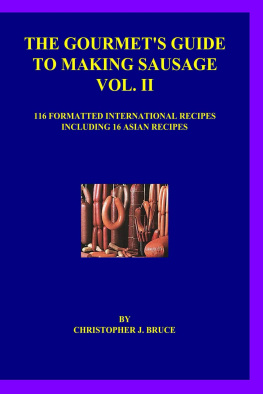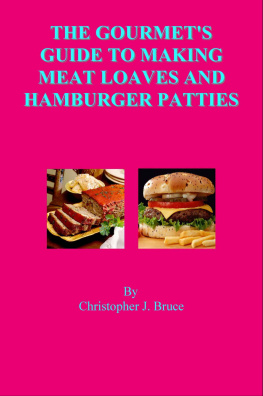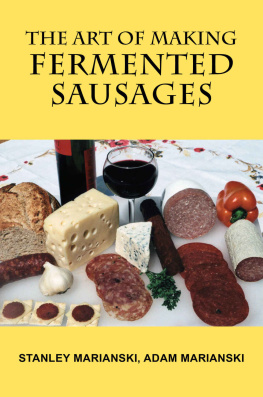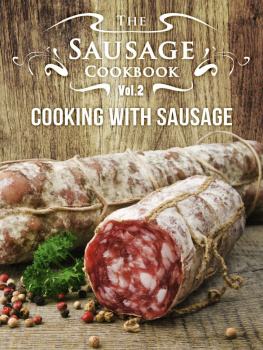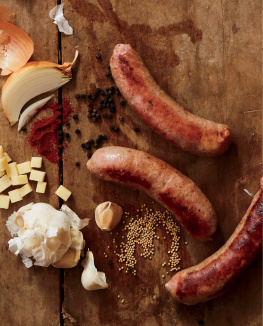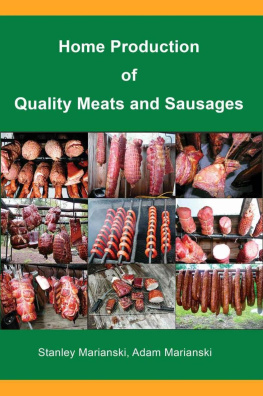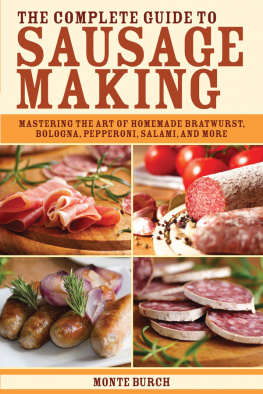THE GOURMETS GUIDE TO MAKING
SAUSAGE VOL. II
116 Formatted International Sausage Recipes
Including 16 Asian Recipes
By
Christopher J. Bruce
PUBLISHED BY:
Christopher J. Bruce
The Gourmets Guide to Making Sausage Vol. II
Copyright 2013 by Christopher J. Bruce
CONTENTS
ACKNOWLEDGEMENTS 1
Equipment 8
Ingredients 14
Acknowledgements
Sausages have been made for thousands of years. Every civilization has some history of sausage making including the Africans, Americans (North and South of both the indigenous and immigrant species), Arabians, Asians, Chinese, Egyptians, Europeans, Greeks, Indians, Mesopotamians, Mongolians, Polynesians, Romans, Russians, Scandinavians, the list is endless. Members of every ethnic group that has ever lived on Earth have all tried sausage making and to credit any single person with having invented any particular sausage would be doing an injustice to the long since dead person that actually did. Suffice it to say that sausages were almost certainly being made before recorded history. Sausages were probably the Neanderthal version of present day fast food. Judging by the standards of some fast foods I would imagine that the quality was better! In any event it is likely that sausages have been made ever since our ancestors became the leading carnivores on the plains of this planet.
I have made sausage as an amateur and professional for over 10 years but I do not claim to have written any of the recipes in this book. In fact I have collected them from every Tom, Dick and Harry I know, and a lot of people I dont, as well as from publications and the Internet. Some of them are exactly as given to me, others have been changed so much from the original version that they would not be recognized by their original authors, some I gleaned from national meat boards and some from companies promoting sales of sausage ingredients, casings or equipment. However, all the recipes have been tried and tested and as far as I am aware, none of my friends or customers ever suffered any ill effects from consuming any sausage the recipe for which is included in this collection.
During the course of my research I often found that there are several different names for what in effect is one single sausage recipe. Even recipes credited to well known chefs are more often than not a variation on a theme. The recipes included in this book vary from the simple to the fairly complicated but all can be used to prepare really delightful sausages in your own kitchen.
To all those people who have taken the time to record recipes which have been handed down from generation to generation and have gone to the trouble of publishing them in one form or another and to those who have collected recipes, recorded their ideas on sausage making and likewise published these in the press, on the internet and in recipe books, I would like to say a very big thank you for making this knowledge available to sausage fans all over the world.
C. J. Bruce, Thailand, July 2013

CHAPTER 1
AUTHORS NOTE AND INTRODUCTION
Authors Note
This book, Vol. II of the Gourmets Guide to Making Sausage, includes 116 sausage recipes of which 16 are for Asian sausages and 14 are repeated from Vol. I. I have repeated 14 recipes because unlike most sausage recipes for which there are alternatives these are unique with no alternative version available. The same straightforward descriptions of the procedures to be followed in order to make very good sausages that appeared in Vol. I have been included in this second volume of recipes. The recipes in this book are once again formatted and standardized to yield 1 lb or 1 kg of sausage per batch.
To those of you who purchased Vol. I of The Gourmets Guide to Making Sausage, please accept my apologies for having repeated the sausage making procedures in this book. I have repeated the procedures in Vol. II for two reasons: the first being that some new readers may not want to purchase Vol. I and the second being that it is convenient for purchasers of both books to have the procedures and general information at hand without having to refer to a second book.
Introduction
As stated previously under Acknowledgements, sausages have been around for a very long time but the modern sausage with which we are so familiar today has been developed and refined in more recent times by craftsmen who have passed on the art of making a good sausage from one generation to the next over the past 1000 years or more. The word sausage comes from the Latin word salsus which means salt or salted and the Romans were making sausage using salt as a preservative over 2000 years ago. At that time salt was in great demand and the modern English word salary is likewise derived from the Latin term for wages which were known as salt money by the Romans. We know that the ancient Egyptians were skilled sausage makers long before the Romans and since then a tradition of sausage making has been fostered by skilled butchers whose knowledge of meat, meat preservation, meat processing methods and the use of herbs and spices has been developed into what, essentially, has become an art form practiced by professionals and amateurs alike throughout the world.
Due to the introduction into Europe of new herbs and spices from both
the New World and Asia in recent history, and the use of locally produced ingredients which varied considerably from one country, region or sometimes even town, to the next, new sausages were developed and often became associated with the country, region or town from which they originated. Typical examples of this are Bologna, Cumberland, Frankfurter, Genoa, Russian, Vienna, Wiener etc. Some sausages are named after the professions or occupations of the people that made them such as boerewors (farmers sausage), jagerwurst (hunters sausage) and others were named after the country from which they originated such as Polish, Russian or Spanish. Finally, others are named after an ingredient like Pepperoni or the season in which they were made or intended to be eaten e.g. summer. I wonder who named the universal hot dog!
The acceleration of sausage development was brought on both by the introduction of the new herbs and spices and by the need to preserve food for growing populations. Sausages provided a means of keeping meat for an extended period of time without refrigeration, especially in warm climates, and it was this that led to the development of dry, semi-dry and dried sausages which could be stored for long periods of time without refrigeration. In cold climates more use was made of fresh sausage which could be kept cold or frozen for months.
Today sausage making is big business with emphasis on quality and food safety, with food safety being of the utmost importance. I have to say that I have eaten many a sausage that left a lot to be desired in terms of quality, especially quality of taste, but to date I have never had a health problem arising from their consumption. One thing is certain and that is that there is nothing quite like a homemade sausage. Admittedly sausage made at home has distinct advantages; you know whats in it, its made to suit your own palate, its economical (unless you add in the cost of your own labor), its easy and its fun. There is also nothing more satisfying than sitting down to a meal of aromatic, soft, juicy, crispy, brown skinned sausage made by your own hands in your own kitchen. If you make sausage for your own immediate consumption it can be largely additive and preservative (i.e. chemical) free. The exceptions that I always make with regard to the addition of chemicals to sausage mixes are sodium nitrate and nitrite which prevent the occurrence of botulism, a food poisoning which is lethal and can lead to paralysis and death. It is essential that you use nitrate and/or nitrite cures when making dry, semi-dry or dried sausage. Nitrate and nitrite are sold under a number of commercial brand names including Prague Powder, Instacure, Modern Cure and Mortons. Botulism is dealt with in more detail in Chapter 4 of this book.

